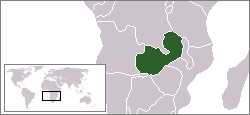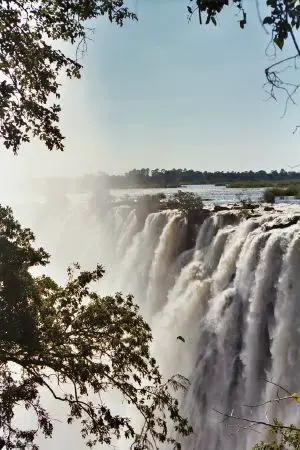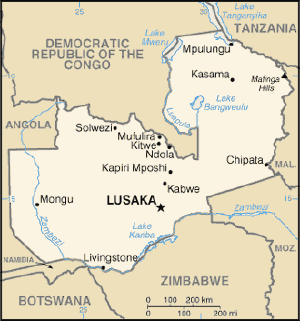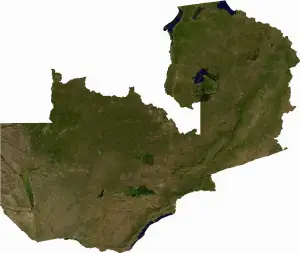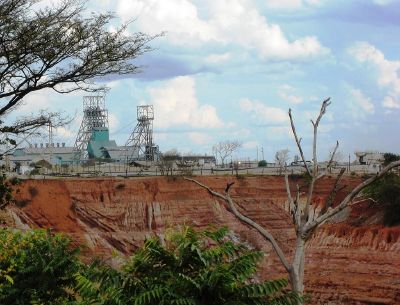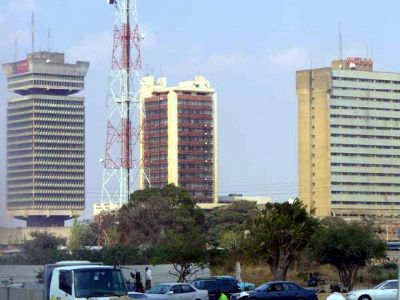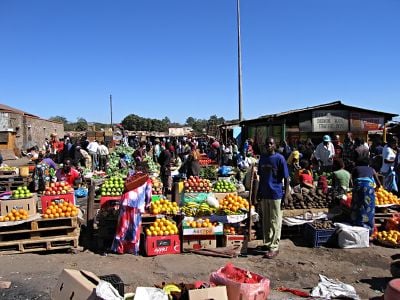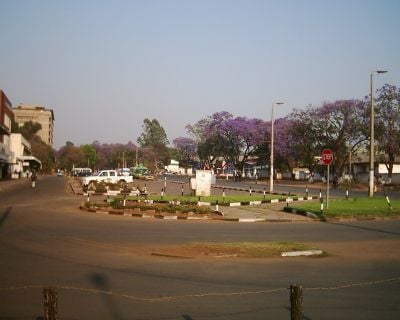Zambia
| Republic of Zambia | ||||||
|---|---|---|---|---|---|---|
|
||||||
| Motto: One Zambia, One Nation | ||||||
| Anthem: "Stand and Sing of Zambia, Proud and Free" |
||||||
| Capital (and largest city) | Lusaka 15¬į25‚Ä≤S 28¬į17‚Ä≤E | |||||
| Official languages | English | |||||
| Recognized regional languages | Chewa, Bemba, Lunda, Tonga, Lozi, Luvale, Kaonde | |||||
| Demonym | Zambian | |||||
| Government | Republic | |||||
|  -  | President | Hakainde Hichilema | ||||
|  -  | Vice President | Inonge Mutukwa Wina | ||||
| Independence | ||||||
|  -  | from the United Kingdom | 24 October 1964  | ||||
| Area | ||||||
|  -  | Total | 752,618 km² [1](39th) 290,587 sq mi  |
||||
|  -  | Water (%) | 1 | ||||
| Population | ||||||
|  -  | 2020 estimate | 18,383,956[2] (71st) | ||||
|  -  | 2010 census | 13,092,666[3]  | ||||
|  -  | Density | 17.2/km² (191st) 44.5/sq mi |
||||
| GDP (PPP) | 2019 estimate | |||||
|  -  | Total | $75.857 billion[4]  | ||||
|  -  | Per capita | $4,148[4]  | ||||
| GDP (nominal) | 2019 estimate | |||||
|  -  | Total | $23.946 billion[4]  | ||||
|  -  | Per capita | $1,307[4]  | ||||
| Gini (2015) | 57.1[5]  | |||||
| Currency | Zambian kwacha (ZMK) |
|||||
| Time zone | CAT (UTC+2) | |||||
|  -  | Summer (DST) | not observed (UTC+2) | ||||
| Internet TLD | .zm | |||||
| Calling code | +260 | |||||
Zambia, officially the Republic of Zambia, is a landlocked country in the central part of southern Africa. Zambia covers an area of 752,614 square kilometers (290,586 square miles). It borders the Democratic Republic of the Congo to the north, Tanzania on the northeast, Malawi on the east, Mozambique, Zimbabwe, Botswana, and Namibia to the south, and Angola on the west.
In 1895 the name "Rhodesia" was applied to the Ndebele territory of Zimbabwe. Rhodesia was then divided into Northern Rhodesia and Southern Rhodesia in 1911. In 1964, Northern Rhodesia became Zambia, the name being derived from the Zambezi River.
Once a wealthy nation, Zambia became engaged in a struggle against crushing poverty, drought, and a rampant AIDS epidemic. By the beginning of the twenty-first century it was of the poorest and least developed nations, ranking 166th out of 177 in the 2003 United Nations Development Report. One in five people was reported infected with HIV and life expectancy had dropped below 40 years of age; young people aged 20-25 were less educated than their parents’ generation.
In the 2000s, fortunately, the economy stabilized, attaining real GDP growth, decreasing interest rates, and increasing levels of trade. Much of its growth was due to foreign investment in Zambia's mining sector and higher copper prices on the world market. This led to Zambia being courted enthusiastically by aid donors, and saw a surge in investor confidence in the country.
History
The indigenous Khoisan (hunter-gatherer) occupants of Zambia began to be displaced by technologically advanced migrating tribes about two thousand years ago.
The Tonga people (also called Batonga) were one of the first cultures to settle in Zambia. The Tonga identified strongly with the Zambezi River, calling themselves Basilwizi (‚Äúthe river people‚ÄĚ).
The Nkoya people also claim a long heritage in Zambia after moving from the Luba-Lunda kingdoms in the north during the great influx between the late-seventeenth and early-nineteenth centuries. These migrants came primarily from southern Democratic Republic of Congo and northern Angola and were joined in the nineteenth century by Ngoni peoples from the south.
The area lay untouched by Europeans for centuries until in the mid-nineteenth century when Western explorers, missionaries, and traders came to what was then known as Northern Rhodesia.
In 1855 missionary and explorer David Livingstone became the first European to see the magnificent waterfalls on the Zambezi River. He named them Victoria Falls after Queen Victoria. The falls are known in Zambia as Mosi-O-Tunya (in the Lozi or Kololo dialect), "the smoke that thunders." The Zambian town of Livingstone, near the falls, is named after him.
Northern Rhodesia was colonized in the 1890s by the British South Africa Company (BSAC), a business group that received a royal charter from the government of Britain in 1888. This charter gave the BSAC and its leader, Cecil Rhodes, permission to colonize the areas north of the Limpopo River on behalf of Britain. In return for undertaking the expense of colonization, the BSAC was given the right to control all mineral resources found in the new colonies.
By 1900 the BSAC gained control of an area of South Central Africa, which was comprised of many different societies and kingdoms and was divided into three colonies: Northern Rhodesia (Zambia), Southern Rhodesia (Zimbabwe), and Nyasaland (Malawi). By 1920 no large deposits of gold or any other minerals were found, so the BSAC was not willing to continue to pay for the colonial governance of these territories. In 1923 the BSAC gave up political control over these territories.
Southern Rhodesia was annexed formally and granted self-government in 1923, and the administration of Northern Rhodesia was transferred to the British Colonial Office in 1924 as a protectorate.
Between 1920 and 1950, large deposits of high quality copper ore were found in Northern Rhodesia and across the border in the Katanga region of the Congo. This discovery happened just as the demand for copper in the west was peaking. In a period of 30 years, Northern Rhodesia developed into one of the world's leading producers of copper.
In 1953, both Rhodesias were joined with Nyasaland (now Malawi) to form the Federation of Rhodesia and Nyasaland. The Federation, also called the Central African Federation, was formed on Britain’s initiative. Under an appointed governor-general, the federal government handled all governmental affairs even though countries retained most of their former legislative structure. In 1960-1961 the Africans demonstrated against the federation. At the core of the controversy were African demands for greater participation in government and European fears of losing political control. Official dissolution came on December 31, 1963, after which Northern Rhodesia became independent as Zambia on October 24, 1964.
The European settlers in Northern Rhodesia never gained the power that settlers did in neighboring Southern Rhodesia (Zimbabwe) and South Africa. But their influence was strong enough to delay political independence in Zambia. While the majority of African colonies obtained independence in 1960 or shortly before, Zambia did not gain independence until 1964.
Southern Rhodesia refused to hand political control over to its African majority, and in 1965 the white government unilaterally proclaimed the colony’s independence from Britain as Rhodesia.
At independence, despite its considerable mineral wealth, Zambia faced major challenges. Domestically, there were few trained and educated Zambians capable of running the government, and the economy was largely dependent on foreign expertise. Three of its neighbors‚ÄĒSouthern Rhodesia and the Portuguese colonies of Mozambique and Angola‚ÄĒremained under white-dominated rule. Zambia's sympathies lay with forces opposing colonial or white-dominated rule, particularly in Southern Rhodesia. During the next decade, it actively supported movements such as the National Union for Total Independence of Angola (UNITA), the Zimbabwe African People's Union (ZAPU), the African National Congress of South Africa (ANC), and the South-West Africa People's Organization (SWAPO).
Conflicts with Rhodesia resulted in the closing of Zambia's borders with that country and severe problems with international transport and power supply. However, the Kariba hydroelectric station on the Zambezi River provided sufficient capacity to satisfy the country's requirements for electricity (despite the fact that the hydro control center was on the Rhodesian side of the border). A railroad to the Tanzanian port of Dar es Salaam, built with Chinese assistance, reduced Zambian dependence on railroad lines south to South Africa and west through an increasingly troubled Angola. Until the completion of the railroad, however, Zambia's major artery for imports and the critical export of copper was along the TanZam Road, running from Zambia to the port cities in Tanzania. Also a pipeline for oil was built from Dar-es-Salaam to Kitwe in Zambia.
By the late 1970s, Mozambique and Angola had attained independence from Portugal. Zimbabwe achieved independence in accordance with the 1979 Lancaster House Agreement, but Zambia's problems were not solved. Civil war in the former Portuguese colonies generated an influx of refugees and caused continuing transportation problems. The Benguela railway, which extended west through Angola, was essentially closed to traffic from Zambia by the late 1970s. Zambia's strong support for the ANC, which had its external headquarters in Lusaka, created security problems as South Africa raided ANC targets in Zambia.
Politics
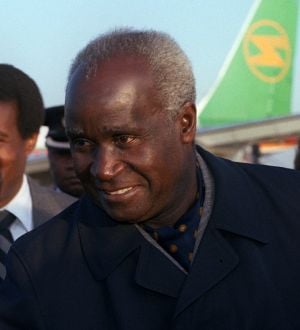
Politics in Zambia takes place in a framework of a presidential system in a representative democratic republic, whereby the president of Zambia is both head of state and head of government, and of a pluriform multi-party system. The government exercises executive power. Legislative power is vested in both the government and parliament. Zambia became a republic immediately upon attaining independence in October 1964.
Kenneth Kaunda was the first president of Zambia, ruling with a single party structure between 1964 and 1991. Formerly an educator, Kaunda began his political career as the founder and Secretary of the Lubwa Branch of the African National Congress (ANC) in 1950. He held various positions until 1953. Kaunda then became secretary general of the Northern Rhodesia African National Congress.
In 1958 Kaunda formed the Zambian African National Congress, of which he became president. In 1960 Kaunda became president of the United National Independence Party (UNIP), a post he held until 1962, and again from 1995 to 2000.
With the development of a new constitution and the advent of Zambia's first black government in 1962, Kaunda became minister of local government and social welfare (1962‚Äď1964) and prime minister of Northern Rhodesia (from January to October 1964).
In addition to his efforts in Zambia, Kaunda was in the forefront of the efforts to liberate all of Africa, serving as the president of the Pan-African Freedom Movement for East, Central and Southern Africa (Pafmesca) in 1962 and as chairman of the Organization of African Unity (OAU) from 1970 to 1973. Kaunda also played key roles in resolving territorial disputes between Kenya and Somalia and the liberation movements in Angola, Mozambique, Namibia, Zimbabwe and South Africa.
In 1991 Kaunda lost the presidential election and in 1992 founded the Kenneth Kaunda Children of Africa Foundation. His foundation initiated an anti-AIDS crusade targeted at youth. It is also dedicated to achieving peace on the African continent with conflict resolution strategies.
He left office after the return of multi-party elections, which his United National Independence Party lost to Frederick Chiluba's Movement for Multiparty Democracy. When Chiluba, a former bus conductor and trade union leader, took over, the constitution was changed to bar anyone whose parents came from outside of the country from holding a post in government. This meant Kuanda could no longer be active in Zambia's politics.
The new government freed the country's collapsing economy from stifling state controls. Guided by the International Monetary Fund and World Bank, it embraced the free market with one of the most ambitious liberalization programs in Africa.
After 10 years, however, many regarded Chiluba's rule as a disappointment. The government's privatization of the copper mines‚ÄĒthe country's biggest asset‚ÄĒwas scandal-ridden. Despite billions of dollars of international aid after he took office, three-quarters of Zambia's population was still living below the World Bank poverty threshold of $1 a day in 2001.
Chiluba failed to convince Zambians that he should be allowed to run for an unconstitutional third term in the December 2001 general elections. Prominent lawyer and former vice president Levy Mwanawasa was chosen by Chiluba and his party to be his successor. This choice was a surprise to many because Mwanawasa had quit as Chiluba's number two in July 1994, saying that his integrity had been "put in doubt."
Mwanawasa received 29.1 percent of the vote and was declared the victor by a narrow margin. Some 70 percent of the population voted for the other 10 candidates. Three parties submitted petitions to the High Court challenging the election results, but to no avail. Mwanawasa stirred controversy when he did not prevent the arraignment of Chiluba in early 2003, on charges of corruption related to massive illicit diversion of state funds and also in 2002 when he refused to accept genetically modified maize, despite strong pressure from the U.S., to meet food shortages.
Mwanawasa presided over the country from January 2002 until his death in August 2008. After Mwanawasa's death, Rupiah Banda presided as Acting President before being elected president in 2008. He is the shortest serving president, having held office for only three years. Patriotic Front party leader, Michael Chilufya Sata defeated Banda in the 2011 elections.
Education
At independence, Zambia had one of the most poorly developed education systems of Britain's former colonies, with just 109 university graduates and less than 0.5 percent of the population estimated to have completed primary education.
The country has since invested heavily in education at all levels, and well over 90 percent of children in the 7‚Äď13 age group attend school. However, of those who enroll for the seven years of primary education, less than 20 percent enter secondary school, and only two percent of the 20‚Äď24 age group enters university or some other form of higher education.
A major factor in the dismal education statistics is the HIV-AIDS epidemic. With one in five dying from AIDS, it affects teachers, parents, and students. Fewer children enroll, especially when they become orphans, and fewer teachers are available to teach. A study in 1999 showed that 56,000 students in Zambia had lost a teacher to AIDS. Currently, more than one million Zambians are HIV positive or have AIDS. An estimated 100,000 died of the epidemic in 2004 and almost three-quarters of a million Zambian children have been orphaned.
Higher Education
Educational opportunities beyond high school are very limited in Zambia. There are few schools offering higher education and most Zambians cannot afford the fees. The University of Zambia, founded in 1966, in Lusaka is the primary institution of higher learning.[6]
In 1987 the government reorganized the University of Zambia at Ndola into Copperbelt University. It now has four faculties after the incorporation of the Zambia Institute of Technology into the university as the School of Technology in 1989, and the creation of the School of Forestry and Wood Science in 1995 later renamed School of Natural Resources in 2001.[7]
In 2004 Northrise University became the latest effort to solve the education problem when Moffat and Doreen Zimba, native Zambians, created an institution to teach ministry and business skills.[8]
Geography
Zambia is a landlocked country (surrounded by eight other countries) in southern Africa, with a tropical climate and consists mostly of high plateau with some hills and mountains. At 290,566 square miles (752,614 square kilometers), it is the 39th-largest country in the world (after Chile) and is slightly larger than the U.S. state of Texas.
The country is dominated by wilderness and its lush river valleys and floodplains offer excellent habitat for a wide range of wildlife species, as do the dense woodlands that cover much of the country. It has 19 national parks, and 31 Game Management Areas designated as buffer zones on the borders of these parks. Its wildlife population includes the lion, leopard, buffalo, elephant and hippo, as well as Sitatunga and Puku antelope and bee-eaters, pelicans, storks and many bird species.
Zambia is drained by two major river basins: the Zambezi River basin, in the south; and the Congo River basin, in the north. Of the two basins, the part of Zambia drained by the Zambezi River basin is about three-quarters of the country's total area.
The Zambezi river basin is home to the Kariba Dam, a hydroelectric dam in the Kariba Gorge of the Zambezi river basin in Zimbabwe. It controls 40 percent of the total runoff of the Zambezi River, thus changing the downstream ecology quite dramatically. When the dam was completed in 1960 it was the largest man-made dam ever built. It provides electric power to both Zambia and Zimbabwe and supports a thriving commercial fishing industry. Kariba Lake, the vast reservoir created by the dam, extends 175 miles (280 kilometers) and has a maximum width of 20 miles (32 kilometers).
The world famous Victoria Falls are on the Zambezi River in the Southern Province, but Zambia has more than 15 other spectacular falls within its borders. Lying on the Northern tip of Zambia in Sumbu National Park is the southern shores of Lake Tanganyika. It borders three other countries and is the longest fresh water lake in the world and the second deepest after Lake Baikal in Russia.
Economy
The Zambian economy relies heavily on the country’s mineral wealth, particularly copper and also cobalt and zinc. These account for the bulk of export earnings and provide essential raw materials for Zambia’s manufacturing industry, which accounts for over one-third of national output.
Output of copper fell to a low of 228,000 metric tons in 1998, after a 30-year decline due to lack of investment, low copper prices, and uncertainty over privatization. In 2002 the Konkola copper mine‚ÄĒthe country‚Äôs largest and a major source of government revenue‚ÄĒwas closed. However, following privatization of the industry, copper production rebounded to 337,000 metric tons. Improvements in the world copper market have magnified the effect of this volume increase on revenues and foreign exchange earnings. Recently firms like Vedanta Resources, a London-based metals giant acquired Konkola Copper Mines (KCM) and have completely transformed the company allowing it to develop to its full potential and maximize the benefits for the employees.
The Zambian government is now pursuing an economic diversification program to reduce the economy's reliance on the copper industry. This initiative seeks to exploit other components of Zambia's rich resource base by promoting agriculture, tourism, gemstone mining, and hydropower.
Apart from raw material processing, the manufacturing sector includes vehicle assembly and oil refining as well as the production of fertilizers, textiles, construction materials, and a variety of consumer products.
Agriculture produces 14 percent of GDP and employs 85 percent of the population. Corn and cattle are the main earners; other crops (cassava, millet, sorghum, and beans) are produced mainly for domestic consumption but have to be supplemented by substantial food imports. Zambia’s hydroelectric projects have allowed it self-sufficiency in energy.
Economic policy changed radically during the 1990s when the government sought the backing of the IMF in tackling Zambia’s serious financial problems. With some difficulty, many of the IMF-imposed measures were put into effect. The economy has been growing (5.1 percent in 2004) but inflation (21 percent) and unemployment (estimated at 50 percent) remain high. Zambia is a member of the Southern African Development Council (SADC).
More than 70 percent of Zambians currently live in poverty. Social indicators continued to decline, particularly in measurements of life expectancy at birth (about 37 years) and maternal mortality (729 per 100,000 pregnancies). The country's rate of economic growth cannot support rapid population growth or the strain which HIV/AIDS related issues (such as rising medical costs, decline in worker productivity) place on government resources. HIV/AIDS is the nation's greatest problem, with 17 percent prevalence among the adult population. HIV/AIDS will continue to ravage Zambian economic, political, cultural, and social development for the foreseeable future.[9]
Demographics
More than a quarter of Zambia's population lives in two urban areas near the center: in the capital, Lusaka, and in the industrial towns of the Copperbelt (Ndola, Kitwe, Chingola, Luanshya and Mufulira). The rest of Zambia is very sparsely populated, particularly the west and the northeast; the majority of people make their living as subsistence farmers.
Zambia's population is comprised of about 72 Bantu-speaking ethnic groups but almost 90 percent of Zambians belong to the eight main ethnolinguistic groups, which are the Bemba, Nyanja-Chewa, Tonga, Lunda, Luvale, Kaonde, Nkoya, and Lozi. Each ethnic group is concentrated in a particular geographic region of the country and many groups are very small and not well known.
Expatriates, mostly British (about 15,000) or South African, live mainly in Lusaka and in the Copperbelt in northern Zambia, where they are employed in mines and related activities. Zambia also has a small but economically important Asian population, most of whom are Indians.
Zambia has a long tradition of hosting refugees and so has a significant population of refugees and asylum seekers.
Religion
The Zambian constitution provides for freedom of religion. Christianity took hold in the country when missionaries came in the late nineteenth century. The country is now 85 percent Christian with Catholicism being in the majority. Anglicans, Methodists, Baptists, and Seventh Day Adventists all have established a presence as well.
While Zambia is predominantly a Christian country, few have totally abandoned all aspects of their traditional beliefs. African traditional religions worship a supreme being or a natural element as the mother or father of the people. Many Zambians believe that the spirits of their ancestors can help them in times of need or difficulty. The Bemba believe that spirits dwell in animals or natural elements like rivers or stones. In the village the power of the traditional healer is unquestioned and it is believed that they can solve disputes and medical ailments because of supernatural powers.
Zambia has a very small Jewish community, composed mostly of white Ashkenazi. Notable among those who grew up in this small community are Simon Zukas, who served as the minister of works and supply and was a member of United National Independence Party, and the economist Stanley Fischer, governor of the Bank of Israel and formerly head of the International Monetary Fund.
Muslim, Hindu, and Baha'i citizens together represent about 2 percent of the population.
Leaders of various ecumenical movements, such as the Zambia Episcopal Conference, the Christian Council of Zambia, and the Evangelical Fellowship of Zambia, hold regular meetings to promote mutual understanding and interfaith dialog, and to discuss national issues.
Culture
Zambia's present-day culture exhibits a blend of historical and cultural features from the past as well as the present.
- Music of Zambia: traditional instruments include the hand piano, a small instrument with iron keys mounted on a rectangular box and plucked by both thumbs. Also the silimba, a xylophone-type instrument with a range of flat wooden keys mounted over gourds. The most common instrument of course is the drum and drumming plays an important part in rituals, ceremonies, and celebrations.
- Basketry: Zambian crafts include some of the finest basketry in Africa. Basketry, practiced by both the men and the women is widespread. The many forms and raw materials include bamboo, liana vines, roots, reeds, grasses, rushes, papyrus palm leaves, bark, and sisal. They are decorated with symbolic designs using traditional dyes made from different colored soils, roots, bark, and leaves.
- Textiles: Tribal Textiles, based in the Luangwa Valley, produce unique individually designed and hand-painted textiles made from 100 percent Zambian cotton. They produce cushion covers, bed covers, table linen, wall hangings, and an extensive range of personal accessories and bags.
- Zambian Languages: Chibemba, Nkoya, Chichewa or Chinyanja, Chilunda or Lunda, ChiTonga or Tonga, Ila, Mambwe, Namwanga, Kaonde, Lozi, Luvale, Shona Shona, Tumbuka, Yauma, Aushi, Lenje, Lamba, Lala, Fanagalo (a pidgin language used mainly used in the South African mines) and others (78 in total).
- Traditional ceremonies: There are more than 20 annual traditional ceremonies in Zambia, manifesting customs, social life, rituals, oral history, material and spiritual culture.
Many of Zambia's rural inhabitants have retained their traditional customs and values. After independence in 1964 the government recognized the role culture was to play in the overall development of a new nation and began to explore the question of a national identity.
As a result, institutions to protect and promote Zambia’s culture were created, including the National Heritage Conservation Commission. Private museums were also founded and cultural villages were established to promote the expression of artistic talents.
Culture clash
One area of Zambia suffered a cultural blow when the Kariba Dam, a double curvature concrete arch dam, was constructed between 1955 and 1959 at a cost of $135 million. Kariba Lake, the vast reservoir created by the dam, extends 175 miles (280 kilometers) and has a maximum width of 20 miles (32 kilometers).
The creation of the reservoir forced resettlement of about 57,000 Tonga people living along the Zambezi in both Zambia and Zimbabwe. The people resettled for the project were forced to leave their homes and fertile lands that had been under cultivation for hundreds of years. They were resettled to poor lands with no development assistance.
Notes
- ‚ÜĎ United Nations Statistics Division, Population by sex, rate of population increase, surface area and density Retrieved August 23, 2021.
- ‚ÜĎ Population, total - Zambia The World Bank. Retrieved August 18, 2021.
- ‚ÜĎ 2010 Census Population Summaries Central Statistical Office, Government of Zambia. Retrieved August 23, 2021.
- ‚ÜĎ 4.0 4.1 4.2 4.3 Zambia International Monetary Fund. Retrieved August 23, 2021.
- ‚ÜĎ Gini index (World Bank estimate) The World Bank. Retrieved August 23, 2021.
- ‚ÜĎ History University of Zambia.] Retrieved August 23, 2021.
- ‚ÜĎ The Copperbelt University Retrieved August 23, 2021.
- ‚ÜĎ About Northrise Northrise University. Retrieved August 23, 2021.
- ‚ÜĎ HIV & AIDS in Zambia Avert, April 15, 2020 avert.org. Retrieved August 23, 2021.
ReferencesISBN links support NWE through referral fees
- Gerrard, John W. Africa Calling: A Medical Missionary in Zambia and Kenya. London: I. B. Tauris, 2001. ISBN 186064659X
- Katulwende, Malama. Bitterness (An African Novel from Zambia). New York: Mondial, 2005. ISBN 159569031X
- Kaunda, Kenneth D. Zambia Shall Be Free: An Autobiography. Portsmouth, NH: Heinemann, 1962. ISBN 0435900048
- Leslie, Jacques. Deep Water: The Epic Struggle over Dams, Displaced People, and the Environment. New York: Farrar, Straus and Giroux, 2005. ISBN 0374281726
- Musambachime, Mwelwa. Basic Facts on Zambia. Bloomington, IN: Authorhouse, 2005. ISBN 1420818082
- Roberts, Andrew. A History of Zambia. Teaneck, NJ: Holmes & Meier Publishers, 1976. ISBN 0841902917
- Rotberg, Robert I. Rise of Nationalism in Central Africa: The Making of Malawi and Zambia, 1873-1964. Cambridge, MA: Harvard University Press, 1965. ISBN 0674771915
- Zukas, Simon. Into Exile and Back. Bookworld Publishers, 2002. ISBN 998224020X
External links
All links retrieved June 13, 2023.
- Zambia Online
- National Assembly of Zambia
- The Zambian ‚Äď Newspaper
- Zambia - CIA World Factbook
- Zambia US Department of State
- Chiluba's legacy to Zambia BBC
- Zambia National Tourist Board
Credits
New World Encyclopedia writers and editors rewrote and completed the Wikipedia article in accordance with New World Encyclopedia standards. This article abides by terms of the Creative Commons CC-by-sa 3.0 License (CC-by-sa), which may be used and disseminated with proper attribution. Credit is due under the terms of this license that can reference both the New World Encyclopedia contributors and the selfless volunteer contributors of the Wikimedia Foundation. To cite this article click here for a list of acceptable citing formats.The history of earlier contributions by wikipedians is accessible to researchers here:
The history of this article since it was imported to New World Encyclopedia:
Note: Some restrictions may apply to use of individual images which are separately licensed.


